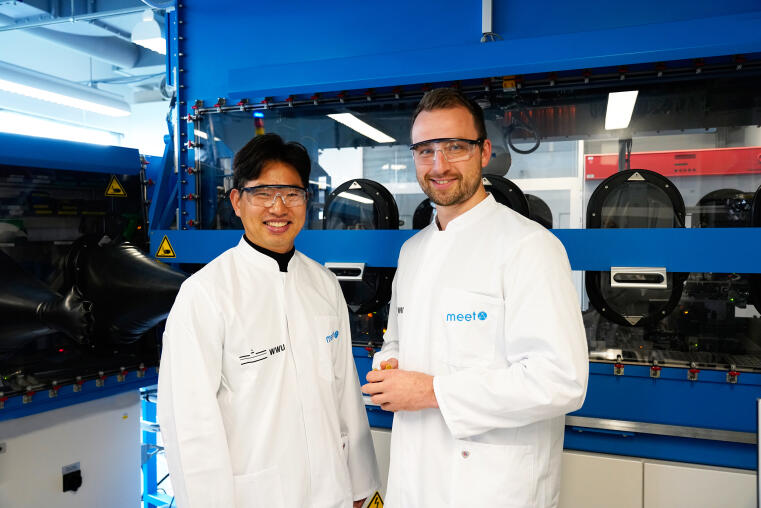“It Is the Cut Between Fundamental Scientific Research and Industrial Interests”
Since the middle of last year, MEET Battery Research Center at the University of Münster and Helmholtz Institute Münster (HI MS) of Forschungszentrum Jülich cooperate with LG Energy Solution (LGES), a leading international manufacturer of battery cells. In joint laboratories in Münster, the three partners conduct research on next-generation batteries. Meanwhile, five dispatchers from South Korea have arrived in Münster and started working with MEET and HI MS researchers. Dr Johannes Kasnatscheew, head of the research division ‘Materials’ at MEET Battery Research Center, and Dr Hyuck Hur, researcher at LGES and scientific coordinator of the cooperation, discuss the current research and the goals of the project.

Welcome in Münster. What initial steps have you already taken to launch the joint research? And what is the Status quo?
Hyuck Hur: We are currently planning our goals of this year. Each work-package is discussing experimental schedules and things to do. We already took the first steps for developing new and even better lithium-ion batteries (LIB).
Johannes Kasnatscheew: For this purpose, we have already started initial experiments in collaboration. We are also finishing the stage of agreement, planning and identification in terms of working package specific targets, initial experiments and scientific goals.
What are these long-term goals and what is the role of science?
Hyuck Hur: The goal of this joint project is developing new technologies to be applied in mass production of next generation lithium-ion batteries. To design new types of Li-ion batteries, fundamental studies in various scientific respects are necessary. New technologies deriving from the deep studies at MEET and HI MS will be applied to LIB products of LGES.
Johannes Kasnatscheew: Indeed, the scientific scope in this project is from the viewpoint of industrial interests. Worth noting, the project-targeted materials with the potential to improve the state-of-the-art LIB are naturally of highest industrial interest, but the related challenges and issues can be resolved and developed only in a scientific manner.
What makes the cooperation between MEET, HI MS and LGES so unique?
Hyuck Hur: The well aligned cooperation between academic institutions (MEET / HI MS) and industry (LGES). MEET and HI MS have strong backgrounds in LIB, and LGES has the necessary infrastructure to test and to produce LIB cells. The cooperation between the three partners will create significant synergy effects in developing next generation LIB.
Johannes Kasnatscheew: It is the cut between fundamental scientific research and industrial interests combined with the opportunity to work in a team, being a unique constellation with a broad disciplinary and cultural background, i.e., full of different and complementary viewpoints, knowledge and expertise. Additionally, the direct contact of the young students from MEET and HI MS with LGES, being a most successful and prominent cell producer, gives unique opportunities to learn from each other – among others – the way of thinking, which can boost target-oriented research and development.
What advantages does the region of Münster and especially the located laboratories offer for the joint research?
Hyuck Hur: Münster has strong expertise and infrastructure to study LIB. Over 400 researches are investigating LIB with various respects. Recently, Münster launched the Fraunhofer Research Institution for Battery Cell Production FFB for the pilot-scale production of LIB. The numerous scientists and the excellent infrastructure make Münster a most fascinating LIB city in Germany. The results from MEET, HI MS, and in the near future from Fraunhofer FFB will speed up the transfer of developed technology towards LGES mass production.
Johannes Kasnatscheew: Münster has a relatively rich history in battery research with abundant experiences and proven achievements. Today, Münster encompasses two established institutions in battery research, MEET and HI MS, and is also the location for the Fraunhofer FFB, built up now. Additionally, there is a strong connection with the University of Münster and its huge department of chemistry and pharmacy with a broad range of disciplines possesses. This environment offers many possibilities for ‘out of box’ ideas and strategies for scientific progress in material and cell development.

